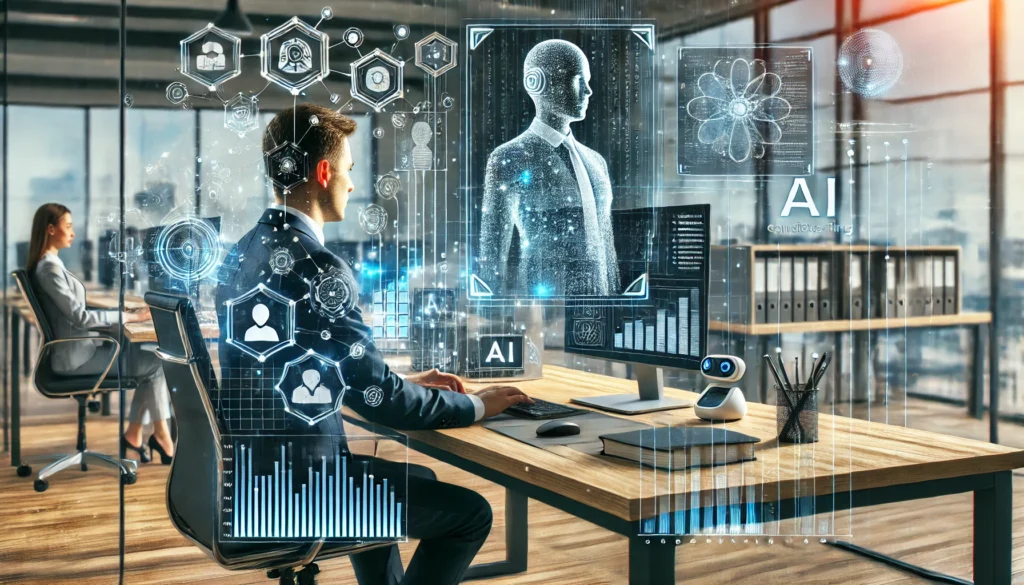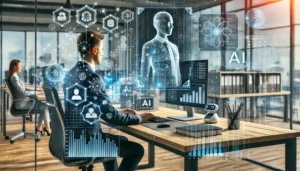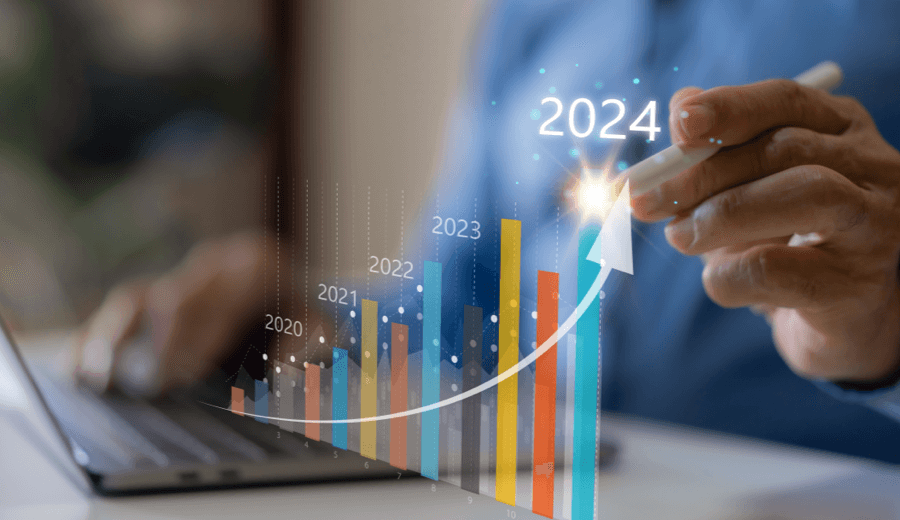With the competition for the best employees rising, businesses turn to AI to improve their hiring tactics. AI recruitment bots speed up and refine candidates’ sourcing, screening, and engagement. These smart tools help automate time-consuming processes and provide useful information to prequalify candidates. According to McKinsey, the use of AI can reduce the time to hire by almost half and increase the quality of hires by one-third.
Integrating AI with HR systems is quite an important aspect as the benefits of AI recruitment bots are fully unlocked when they can seamlessly exchange data with other HR applications used in the organization. According to Deloitte, 75% of hiring professionals believe that seamless HR technology integration is crucial for their functioning. However, there are issues like legacy systems, data silos, and variations in technological readiness levels that organizations face.
This article discusses how to incorporate AI recruitment bots into existing HR platforms, the problems that may be encountered, and the advantages the unified recruitment system presents for companies. By following these guidelines, businesses will be able to better integrate AI practices in their recruitment processes by taking into account their HR objectives, and therefore be both efficient and effective.
Best Practices for Seamless Integration
For AI recruitment bots to complement current HR systems, it is important to understand the current technologies, organization needs, and scalability potential. When Integrating AI with HR systems, it is recommended that organizations adhere to the following best practices to make the most of these powerful tools.
Assessment of Current HR Systems
It is critical to be aware of the current state of the HR technology ecosystem before going for AI and HR tech integration. This involves assessing Recruitment Information Management Systems (RIMS), Applicant Tracking Systems (ATS), Human Resource Information Systems (HRIS), and other applications that support the recruitment process. In a survey by SHRM 68% of the HR professionals indicated it was important for them to understand their current tech stack before integrating AI with HR systems. This assessment enables one to see areas of compatibility and the areas in which the AI recruitment bot will be most useful.
Defining Integration Goals
Measurable and concrete integration goals are equally important for guiding the process and ensuring that the AI recruitment bot aligns with organizational objectives. In cases where the objective is to reduce time-to-hire, enhance the applicant journey, or enrich the data gathered, it is easier to assess the efficacy of the integration if there are goals in place. For instance, Talent Tech Labs reveals that when organizations have specific objectives for AI usage, their recruiting effectiveness improves by 30% in the first year of AI usage.
Choosing the Right AI Recruitment Bot
Choosing the right AI recruitment bot is important to ensure a proper fit. When choosing bots, organizations should consider the existing HR systems, current and future capacity, and integration options. According to a 2024 Gartner report, 72 percent of organizations struggled less with integration issues when they opted for AI solutions compatible with their technology landscapes. Furthermore, it is advantageous to select vendors that provide customer support and the ability to customize the bot for specific human resources activities.
Phased Integration Approach
Integration risk can be managed and avoided through a phased integration process where the integrations are done gradually. Introduce the AI recruitment bot gradually by first using it in a selected stage of recruitment like pre-screening or initial round of interviews. This approach enables one to assess the compatibility of the two systems for integration before implementing the solution at large. Based on the report by PwC, firms that implemented phased implementation procedures incurred a quarter of the disruption levels in contrast to those that tried total integration.
Training and Support
The success of integrating the AI recruitment bot also depends on the willingness of the HR departments to embrace the AI tool. A crucial part of this process is making sure that employees receive broad training on the new system and how it works, as well as the specific benefits of AI in recruitment. Research conducted by Deloitte also revealed that HR departments that provided extensive training in the AI integration phase were rated higher and adopted the technology faster with 64% compliance. Moreover, post-implementation support from the vendor or internal IT staff is required to solve problems that may occur after the integration and fine-tune the system.
By following these recommendations, organizations can not only integrate the AI recruitment bots with the existing HR systems more efficiently but also pave the way for improved recruitment results and sustainable organizational performance.
Try PreScreen AI for Free
Don’t miss out on the opportunity to experience all the benefits of AI-powered interviews firsthand – try our free trial today.
Challenges and Solutions in Merging AI with Current HR Tech

AI and HR tech integration presents significant opportunities for companies, but this integration is not without concerns. Some common challenges that organizations face include compatibility of data, modifications to the system, security issues, and transitions. Mitigating these challenges with appropriate solutions is also very viable to avoid any hitches in the seamless HR technology integration process.
Data Integration and Synchronization
Perhaps the most typical difficulty when implementing AI recruitment bots is how to synchronize the data between the new AI tools and other HR software. Different format of data, old systems, and data in isolation poses some of the AI and HR tech integration challenges. In a report by IBM, 58% of organizations stated that data integration was a major challenge in integrating AI with HR systems. Lack of proper synchronization can result in discrepancies, mistakes, and slowness in the recruitment process.
Solution: One way to overcome this challenge is to use middleware or application programming interfaces (APIs) to facilitate data exchange between the systems. Middleware can be seen as a translator and guarantees that data is in a form that is understandable to the application layer; APIs act as real-time interfaces between the AI recruitment bot and other HR systems. It is also important to carry out the data audit before the integration to identify any issues related to data quality and organization.
Customization and Flexibility
AI recruitment bots can be programmed with basic functions and may not always be customized to fit an organization’s human resource management processes. Adapting these bots to specific business processes and environments may not be a simple process. In fact, a recent poll conducted by HR Tech Weekly showed that 45% of HR professionals reported that the inability of AI tools to work flexibly was one of the biggest obstacles to the technology’s implementation.
Solution: It is recommended that organizations focus on AI recruitment bots that can provide complex configurations. It is also important to work with vendors that offer open solutions or to work with in-house developers to adapt the bots to the needs of the organization. Customization not only improves the performance of the bot but also helps in getting better adoption rates from the users since the technology is built around the processes.
Security and Compliance Concerns
AI recruitment bots bring new security and compliance concerns into the picture, especially regarding data privacy and protection. Since such bots usually work with personal candidate data, it is crucial to guarantee that the integration meets the standards of GDPR or CCPA. McAfee reported that 63% of organizations are concerned about the security risks that come with implementing AI in their human resource systems.
Solution: To address security issues, organizations should employ effective encryption measures, frequently review security issues, and make sure all systems meet the required standards. Partnering with AI vendors who consider security and provide compliance options, including data masking and permission management, is also necessary. However, the risks can be managed effectively by devising internal policies and training programs to ensure data security within the organization.
Managing Change Resistance
AI recruitment bots may be integrated into existing systems in the human resources department, and this can cause rejection by HR professionals who are used to conventional processes. This resistance can be due to a perceived threat to their jobs, or lack of knowledge of how the technology works, or doubts that the bot will produce good results. Harvard Business Review also revealed that 47% of HR leaders described change resistance as an obstacle to AI implementation.
Solution: Managing resistance presents a strategy that involves communication, involvement of the stakeholders, and training. HR leaders should promote the advantages of AI adoption, including minimizing clerical work and enabling HR managers to spend more time on high-value tasks. Involving heads of departments in the process of implementation and providing practical sessions can reduce uncertainty and lead to more effective implementation. Further, sharing success stories of other organizations that have implemented AI in recruitment could be useful in highlighting the positive effects of AI on recruitment results.
By solving these issues with specific solutions, organizations can increase the possibility of a seamless HR technology integration of AI recruitment bots with the current HR systems. This not only optimizes the organization’s recruitment processes but also places it in good stead to harness the benefits of AI in recruitment in the future.
Try PreScreen AI for Free
Don’t miss out on the opportunity to experience all the benefits of AI-powered interviews firsthand – try our free trial today.
Maximizing the Benefits of a Unified Recruitment System

Integrating AI with HR systems through AI recruitment bots is not just an add-on to the current HR systems but the next step toward the future. However, to get the best out of a centralized and unified recruitment system, there is a need to address the aspects of workflow, data analysis, and strategic planning for the future. This approach leads to a more effective, flexible, and sustainable recruitment process that is complementary to other organizational goals.
Improving Candidate Experience
The effective use of AI bots in the unified recruitment system will greatly improve the candidate experience, which is vital in attracting the best talent. As outlined in LinkedIn’s Global Talent Trends report, 83% of candidates will change their impression of an organization based on their experience during the interview. AI and HR tech integration can help in repetitive tasks like scheduling interviews and giving immediate feedback, making the candidate experience much more seamless and generally positive. For instance, a PwC study conducted in 2024 revealed that companies that employed AI in candidate engagement recorded a 30% increase in candidate satisfaction scores.
Enhanced Data-Driven Decision-Making
The use of AI recruitment bots helps in centralizing data from several areas, offering an overarching view of the recruitment process. This integrated approach to data helps the HR teams to make better decisions based on data insights. According to Deloitte, 71% of companies that adopted AI and HR tech integration stated that it helped them enhance the process of data analysis and decision-making in recruitment. When recruitment is centralized, it is easier to track key performance indicators such as the time taken to hire and the cost incurred to fill a position and identify patterns that can lead to optimization of the process. For example, predictive analytics can help determine which sourcing channels are more productive and thus allocate resources more efficiently.
Automated Recruitment Workflows
Integrating AI with HR systems minimizes the routine tasks performed by the human resource professionals allowing them to dedicate their time to more important issues. For instance, when a new candidate applies for a position and gets a “New” status in the ATS, PreScreen AI bot automatically sends them an interview invitation via email. After the interview, we update the candidate’s status and add relevant details and conversation history to the ATS. The benefit is that the recruiter only needs to use one unified recruitment system to manage candidates.
Alternatively, from the PreScreenAI Admin UI, recruiters can download candidates with a specific status from SmartRecruiters, and the system will automatically send interview invitations to them via email. The benefit here is that only candidates with certain statuses are interviewed by the bot, giving the recruiter more control.
The Brandon Hall Group went on to discover that, through automating recruitment activities, the average time taken to fill positions was reduced by 40 %. Efficient processes result in accelerated time to fill, lower expenses, and better adaptation to organizational requirements. Seamless HR technology integration through AI bots also makes candidate screening free from bias, which increases the chances of hiring a diverse workforce.
Scalability and Future-Proofing
Organizations may grow and their recruitment needs may change meaning that new systems that can handle the expansion need to be implemented. A single recruitment system with integrated AI bots is inherently scalable, meaning it can easily expand to handle a higher volume of hires without compromising effectiveness. As per a report from Gartner, 67% of HR leaders think that scalability is very important when it comes to recruitment technologies. A scalable system means that organizations can be prepared to cope with high recruitment demands during certain periods, such as during expansion or the holidays. Furthermore, preparing the HR tech stack for the future enables organizations to incorporate new AI features as they become available.
By leveraging AI and HR tech integration within a unified recruitment system, organizations can maximize the benefits of AI in recruitment, leading to more efficient, scalable, and future-proof hiring processes.
Try PreScreen AI for Free
Don’t miss out on the opportunity to experience all the benefits of AI-powered interviews firsthand – try our free trial today.
Final Thoughts
The use of AI recruitment bots is not simply a technological addition to existing HR options, but a solution that offers strategic improvements to the recruitment process across the board. Integrating AI with HR systems can lead to substantial improvements when done correctly by evaluating current HR systems, establishing goals for integration, and overcoming obstacles such as data integration. AI and HR tech integration provides a better candidate experience, making your organization more appealing to top talent.
To support this claim, several case studies demonstrate how AI recruitment bots can be useful when incorporated with other HR applications. For example, a Fortune 500 company that adopted AI recruitment bots within its ATS was able to cut the time to hire by 50% and boost the quality of candidates by a quarter. Likewise, a large retail chain noted a 30% reduction in recruitment costs attributed to the implementation of an AI-based unified recruitment system.
The examples above show that, AI recruitment bots can improve recruitment results, hence affecting overall business performance. In summary, the benefits of AI in recruitment are clear, and unifying your recruitment system with AI integration positions your organization for success in the ever-evolving landscape of talent acquisition.
Related Articles
An 8-Step Approach to Adapting to Hiring Dynamics for Businesses
Organizations are learning how to adapt to a rapidly changing job market that favors remote work, the...
When to Implement AI in Your Talent Strategy and How to Assess its Fit for Your Organization’s Needs
AI in recruitment is a game-changer as it is able to match talents with opportunities more efficiently...
Solving Talent Acquisition Challenges with AI
Recruitment effectiveness is crucial when it comes to helping organizations capture and retain the best employees in...




